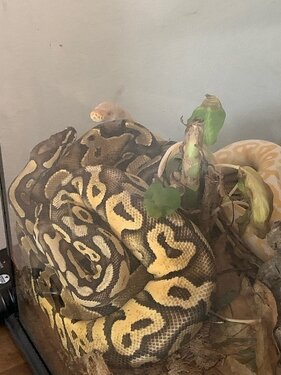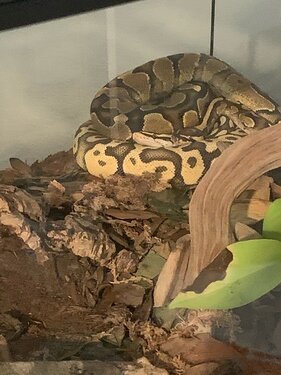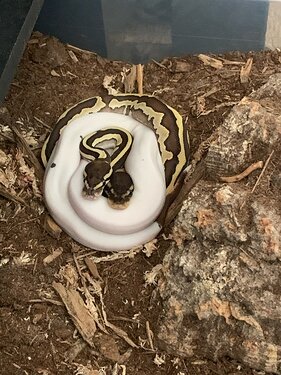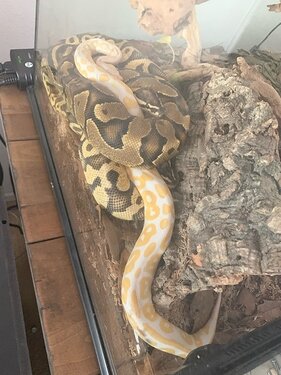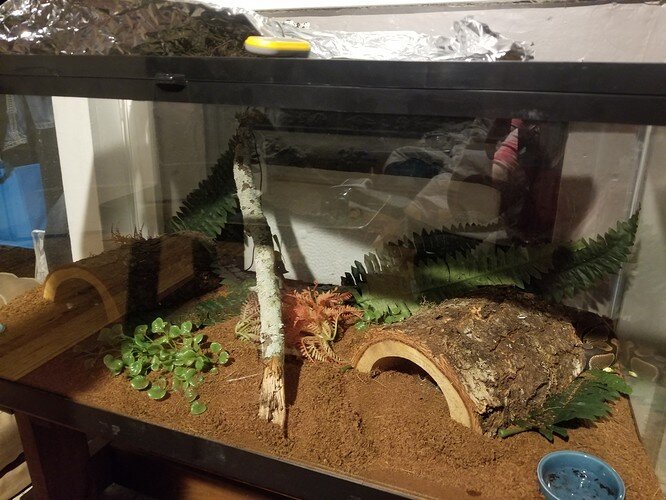Yeah, I just think it’s particularly important to emphasize the attention to risks here - rack isolation, thoughtful procedures, near-constant observation, lots of position ‘sampling’ especially for the first few weeks. There’s a clear set of things that can go wrong wrt behavior or health, and I want to measure and control for them as best I can…especially if I’m going to introduce additional risks to new animals for potential educational or behavioral gains.
I used to use that trick with stressed hatchling balls.
If I found one snake was a little more nervous, I would put a confident snake of the same sex and clutch in the tub with the nervous snake. I only kept them together for maybe 2-3 weeks. What I found happened, is that day by day the nervous snake would slowly start to relax. I think it’s because the touching and shared positions of the snakes helped make the nervous snake less sensitive to touch and interaction. Almost every time I did this, I’ve done it 4 times, I found the nervous snake would accept handling much faster than a snake of the same demeanor without a tub mate. I think this is a good way to get nervous snakes more “tame” and used to interactions, which in turn makes handling much less stressful for them. Definitely like what you’re doing with this experiment, and I can’t wait to hear more updates with what you find in the coming weeks.
Ive been going to the same local specialty reptile store weekly for almost two years now to buy feeders for my snake and each visit i would always check out their ball python enclosure displays where they keep multiple of atleast 3-5 balls together in one enclosure(I’m guessing separated by sex). They have one particular enclosure with atleast 5 adult balls they use for “renting”(I’m guessing for films or children bday parties. I live in Los Angeles). These snakes are always with another whether in a hide, soaking in a water bowl or just hanging out. Ive never seen any weird behavior and all of these same snakes have been together for years even before i started going to them for feeders ~2years ago. Maybe the store is doing it out of space convenience. I dont know but it works for them and these snakes all look happy, healthy and thriving. Ive been very tempted recently to try it since i have a pretty big enough set up for my sole docile female but figuring out how to pull it off properly is something you cant goggle since the internet is mostly set in keeping them solitary. Great thread. Can’t wait for the final consensus 
Keep up the interesting posts.
Interesting read and lots of good info. I love to see people having respectful conversations if with different opinions. That seems to be very rare in these times. When I was a child my stepdad and mom had 2 adult ball pythons that were cohabbed and they were supposed to have been a male and female. But like I said i was a child and I couldn’t tell you 100% if they were properly sexed or not. We always fed seperate buy I never saw any issues with the 2. Have not tried any cohab myself since i started purchasing snakes myslef
@wesjohnson87 - how is this coming along?
It would be interesting to hear some updates, good or bad.
100% uneventful, except for me bombing my first pass at a tank vivarium with root rot  - if there was an incident with the snakes I’d report since I wouldn’t want people to follow my lead.
- if there was an incident with the snakes I’d report since I wouldn’t want people to follow my lead.
All three pairings are still together, and I’m convinced enough that the cohabitation is positively constructive that I’ve stopped giving it much thought. I have no qualms continuing this practice with a modest increase in attention so long as the environment has enough space and the girls are similarly sized (or maybe more accurately, that the smallest is relatively large enough to hold her own…Popcorn is like 1/6 the size of her companions and has no issues).
All girls continue to overwhelmingly choose contact. Very rare to see them apart - typically one will separate a bit to a new location during shed, but even that doesn’t imply social isolation…I’ve noticed the others ‘joining’ for shorter periods (up to a few hours at a time). I’ve seen NERD Kevin talking about contact as a form of communication in his videos, and I overwhelmingly corroborate this belief.
The three in the 55g tank continue to do well, and I think I see some modest differentiation in relationships - Popcorn tends to follow Solana in the event that Solana and Pyra are in separate spots.
The BEL twins are…weird. Even the breeder thought the clutch had strangely calm/social behaviors from birth. They’re so curious and chill that they come to the front of the opened rack and crawl into my hands. If I pick up one, the other always crawls forward and watches. Best zero-stress snakes ever.
Freckles and Terra worked out as expected. Within a week Freckles was significantly less wiley, although she did take some handling before completely relaxing with human contact. She stopped nipping after the pairing, though. I think this is really key…putting a defensive snake with a calm one made her immediately less, not more, defensive.
In general, no signs of elevated stress - all are eating and shedding and pooping like champs.
Some more pics.
This has been interesting, I hope you’ll continually keep us updated . I wonder if you seperate them in the future how they would react. And then again rejoined them. Do you ever seperate for any reason as it stands? I’m curious of the long term affect of all this and starting hatchlings together vs. introducing older snakes together. I won’t be attempting this any time soon myself but it’s deffinetly interesting.
Nothing beyond short separations for handling and feeding. I’ll be doing some trial separations in the next few months…I really want to see isolation response (esp any changes to feeding) and the reintroduction response after, say, a month apart. If that social response is measurable and positive, I’ll probably just order some larger enclosures so they can all stay together as adults 
That would also beg the question of how to best handle breeding season…buut, issues for later.
I’m not all the way caught up with the replies but one thing that I think is worth adding is that I strongly suspect that successful cohabitation has a lot to do with the individual snakes’ personality as well as the environment. I suspect that if you have a particularly dominant snake with one that is more passive then there will be more competitive and dominating behaviors, and more stress, than with two more passive individuals. Which means that individual success or failures of cohabitation are dependent not just on easily measurable variables like age, sex, size, enclosure space, enclosure type, feeding routine etc but also on the behavioral characteristics of the individual snakes involved. Which is something much more difficult to translate into data.
Also, having spent most of my life working with horses, I’m not going to lie, having animals that do just fine without complex herd structures that involve hierarchy enforced by a lot of teeth and hooves is a nice change of pace. 
Interesting read!
I like the fact that you are stating the facts that you are witnessing. Many people will disagree with you lol I will add something I witnessed a long time ago.
When I was about 14 I went to a breeder in Las Vegas. He had a massive tank ( 18ft x 6FTx4FT) There was 3-4 ball python (1 male 2-3 females) and 3 Red tail boas in there and i watched him pull a clutch of eggs out of that tank. I remember him showing me the litter of boas that were produced in that same environment. Now with that being said personally I would never do something like that but it was definitely experience I will never forget seeing.
It takes a healthy animal to produce offspring and I do believe stress is a big factor as well. So they could not have been that stressed. Not all the animals were in hides, some were perched in a branch and some were basking. It was pretty cool to see as a child.
I’ve been following this thread and had done my own cohabitating with my 2 females. 1 is about 1k grams and the other 1400. 55 gallons with multiple hides heated areas and plenty of places to hide separately. Now my first which is the 1k gram one was always super tame and never head shy let’s anyone pick her up and just chills. The 1400 one was always head shy but after about a mo th of them cohabitating and me getting them out regularly the second one is no longer head shy. They always seem to follow the other one out the hide as they love to be curious together. I feed them separately. As one only does asf rats. They both have gained weight no problem clean sheds and show no signs of stress. I check on them multiple times a day and so far 2 mo the later everything still looks good. Just figured I would share my experience as this has been a nice thread and read.
Thanks for sharing! It’s super interesting to me to see something so against years and years of standard practice in the hobby that appears like it may have some validity. I would like to see some more experienced keepers look into a experimenting with this a little more.
In my experience, some species do very well in a natural setup and some are much more practical in the sterile setup. What’s best for the health of the animals is the direction I tend to take.
So I was recently given two adult ball pythons by someone who couldn’t take care of them anymore. I was told they’ve been housed in the same cage their whole lives and they show no signs of aggression towards each other. However I have had a couple instances of aggression towards me when I went to get them out to handle them. I’m hoping that it’s just because they’re stressed from the move and that they will settle in here soon. Does anyone have any tips for getting them to relax? Should I separate them for a while to see if they’re more relaxed apart? I have two glass tanks, one that is 18in wide, 72in long, and 24in tall and another that is 48in wide, 60in long, and 48in tall. Theyre currently in the one thats only 18 inches wide because they came in that one and I didn’t want to stress them out even more after they got here by trying to put them in the one 48in wide which I already had. I’ve never kept more than one snake in an enclosure so this is totally new to me. Any feedback is welcome and appreciated!!!
I would separate them its like here at work they say we been doing it this way for years but that doesn’t always mean its the best way . Does co habitation work yes it can in a pinch or short term but in this case you don’t have the need for it so I personally wouldn’t. As far as stress goes I think that I would just do it and get it over with if you plan to do it cause it would be worse for the to be stressed out get comfortable in the new spot and then you move them and stress them again I would say just get it all over with in one shot. Just my 2 cents I hope it help’s and what ever you do they thrive and have a great life with you.
This has been an interesting read for sure
3 posts were split to a new topic: Why do my ball pythons act like they want to be together?
Your observations are very interesting and I will probably come back to this thread tomorrow once I’ve digested it with some rest. I will say what popped into my mind first though before I flit away
I don’t know whether you’re on to something or not. However I will note, that I’ve watched a lot of harping vids and I’ve seen corn snakes curled up together under bark or a log pretty often (other types of small snakes as well).
And I will also note from personal experience, that I believe aquatic snails show socializing behavior preferences, so if snails can show it why not snakes occasionally in certain cases? Snails are extremely simple creatures. My ramshorns, pond snails, and mystery snails (I know the scientific names for those but please dont ask me to remember right now haha, I do need bed rest) all 3 species REALLY do seem to enjoy each others company. You really have to watch a tank of healthy robust snails do their thing to see what I mean, it’s pretty fabulous. They ride around on each other like piggyback, they seem to play together in the water flow of bubbles, they eat together in little groups and sleep together in their little groups. If you have snails exclusively in a tank and no fish, the snails will build invisible mucus elevators all over the vegetation in the tank and you’ll see lines of snails three or four or five deep riding on each others backs up and down these invisible elevator threads, it’s pretty amazing actually! And when I have to pull snails out because they breed fast and I trade them to the pet store for fish food, the rest of the ones left truly do seem to sulk for a couple days before they go back to usual activities.
So if snails can show basic social preferences why not some reptiles? After all, they are not emotionless robots. They can suss out whether their keepers, we, are dangerous or not. They learn when we are going to handle them and that they’re safe. They get used to us. And sometimes even seem to enjoy exploring when taken out. They can grow confident over time that a situation is safe and maybe even that brings them some kind of comfort we cannot truly empathize with, nevertheless the emotion exists. So why can’t they learn that another creature that feels and looks similar to them, looks that trigger that “it’s another of me” instinct that some creatures truly seem to have deep inside, why can’t they learn to associate that with a sense of safety and comfort if the pairing proves beneficial to their survival?
Anyway, I’m going on here. I don’t know whether your experiments are dangerous or not, I am nowhere near experienced enough to make that call, but I am definitely interested to see how things develop over time for you!
I know this is a late reply to all of this. I have been around snakes my whole life and have done tons of research. Still learning tons. But a couple weeks ago, me and my husband bought our first 2 snakes. Roughly the same size and from the same breeder. The man we got them from said it would be fine for them to be in the same tank. I had never done any research on it before hand. So we took his word.
Obviously, I am now aware that it is frowned upon to cohabit BPs. But it is going on 3 weeks now with them being together, separate hides and same undertank heating pads. We keep close attention to temperature and humidity.
Both females, Lucy is alot more adventurous and Stevie was very shy. Now, Lucy has chilled out (still seemingly unstressed) and Stevie does not ball up anymore. They both are fed separately and have no problem with feeding.
They had chosen their own hides in the tank and stayed fairly separated. Over time they would check out each others hides and move on. Today I went to get Lucy and give her some attention. When I lifted her hide, they were both there. Very relaxed and their heads were side by side. When I had lifted the hide, they both raised their heads slightly to see me and that was it.
They seem to be way more relaxed then when we first got them. And again, never had any issue with feeding in a separate location. I keep a close eye on them due to the fact that there are so many accounts of this going wrong. But so far everything has been going great.
Here is Lucy and Stevie!!!
